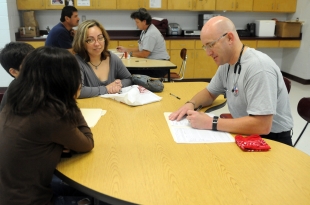Texans Train for Disaster With Humanitarian Mission
Staff Sgt. Daniel Griego, 100th Mobile Public Affairs Detachment
2010/07/28
 WESLACO, Texas - "What we do and what we're training for is a mass casualty," said Texas State Guard Capt. James R. Owens, a registered nurse with the DFW Medical Group. "It's about taking care of the population."
WESLACO, Texas - "What we do and what we're training for is a mass casualty," said Texas State Guard Capt. James R. Owens, a registered nurse with the DFW Medical Group. "It's about taking care of the population."
For the joint members of the Texas Military Forces, the Department of State Health Services and local civil agencies, preparedness means more than a ready standing force. With the persistent threat of hurricanes, flooding and seasonal pandemics, preparedness requires a fully trained, joint force capable of engaging a large-scale incident anywhere in the state.
This year, these state assets used the annual humanitarian event Operation Lone Star to conduct a complete exercise simulating a mass casualty incident. Providing the Rio Grande Valley with immunizations, physicals and various other medical services, the mission sought to stress and challenge the capabilities of state military and civilian departments, as well as reinforce their cooperation and inter-agency communication.
"At one level, we provide free care," said Dr. Brian R. Smith, lead for the public health agency sponsoring OLS and the regional medical director for Health Service Region 11. "At the same time, it provides a preparedness exercise for those of us in public health and the Texas Military forces to work together and to practice together in a major event."
Among the state agencies supporting the operation is the Texas Medical Assistance Team (TexMAT-1), populated by paramedics and medical practitioners from through the state.
"It's an opportunity under a training scenario to see a lot of people at one time," said Charles A. Neely, an EMT paramedic with TexMAT-1. "It just improves our capabilities in the long run."
The two-week operation, running from July 26 through August 6, featured sites in Brownsville, Palmview, Raymondville and San Juan during the first week and will include Laredo, Rio Grande City and Zapata during the second week. Many OLS locations rotate from year to year, but tend to stay centralized in local high schools or elementary schools.
Further bridging the spirit of cooperation, even service members from the Czech Republic and Chilean armies supported OLS this year.
"We need to practice for any kind of mass casualty occasion, too," said Capt. Petra Matulkova, an epidemiologist with the Czech Army. "We need to know these things, being military doctors."
With so many organizations working together, key leaders placed a premium on clear and effective communication throughout the operation.
"A lot of the training that we're doing is being able to communicate," said Owens. "At any level, at any issue, we will have to be able to communicate."
This finely tuned coordination allowed OLS to process 12,645 area residents in 2009, a number that event organizers expect will only grow in 2010 and future years.
Spanning six counties in Texas, Operation Lone Star functions as an ideal execution of a real-time public health crisis, uniting disparate agencies for a common and worthy goal.
"We set it up just as if we may have a thousand people or one person that needs the services," said Owens. "It may be small at one area or larger at another, but in the grand scheme of things, it provides a very good and very applicable training exercise for our units."